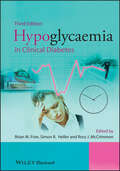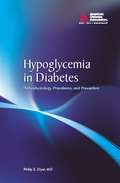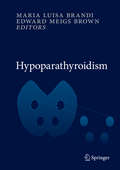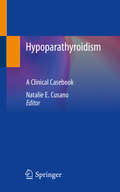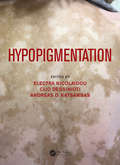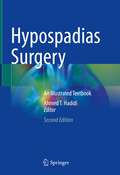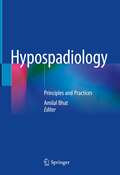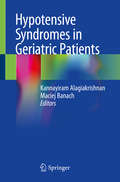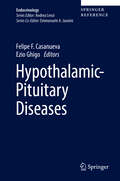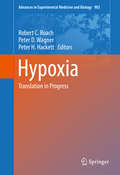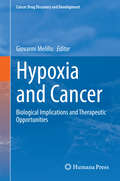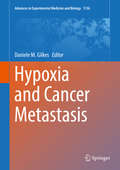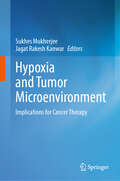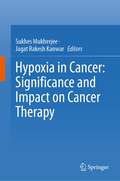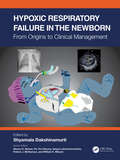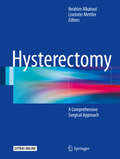- Table View
- List View
Hypofractionated and Stereotactic Radiation Therapy: A Practical Guide
by Orit Kaidar-Person Ronald ChenThis new edition summarizes the data and techniques for hypofractionation and stereotactic radiation in a clinically-accessible way. Hypofractionated radiation therapy, which consists of larger-dose radiation treatments that are given over a shorter time period compared to conventional radiation fraction sizes, is used to treat a variety of cancers, including prostate, breast, lung, and colorectal. Conventional radiation therapy and hypofractionated radiation therapy often have different effectiveness rates for cancer treatment and have different impacts on normal tissues in terms of causing toxicity. There is a significant and continually evolving body of literature on the use of different dosing regimens to treat a variety of cancers, and radiation oncologists need to keep up with the various dosing schedules, the effect of each regimen on cancer control in different cancers, and how the different schedules affect each organ in terms of toxicity. This book provides concise, up-to-date information ranging from commonly-used dose-fractionation schemes for hypofractionated and stereotactic body radiotherapy to simulation and treatment specifications to published safety and efficacy data. Chapters additionally examine the biological rationales for the efficacy of hypofractionated radiation; present clinical studies that demonstrate the efficacy and safety of hypofractionated radiation treatment in a variety of cancers; and describe the advances in technology that have allowed hypofractionated radiation to be safely given. All chapters are fully revised with the latest treatments and updated effectiveness and toxicity of previously discussed treatments, all based on recent clinical trials and large analytical studies. This is an ideal guide for radiation oncology clinicians and trainees.
Hypoglycaemia in Clinical Diabetes
by Brian M. Frier Rory Mccrimmon Simon HellerHypoglycaemia in Clinical Diabetes, 3rd EditionEdited by:Brian M Frier, Royal Infirmary of Edinburgh, Edinburgh, UK Simon R Heller, University of Sheffield, Sheffield, UKRory J McCrimmon, University of Dundee, Dundee, UK If you regularly see patients with diabetes who experience hypoglycaemia and need expert guidance, then this is the book for you.Hypoglycaemia in Clinical Diabetes, 3rd Edition once again provides health professionals involved in the management of people with diabetes with an expertly written, comprehensive guide to hypoglycaemia, the most common and feared side effect of insulin treatment for diabetes. With reference to ADA and EASD guidelines throughout, topics covered include the physiology of hypoglycaemia and the body's response to a low blood glucose, its presentation and clinical features, potential morbidity and optimal clinical management in order to achieve and maintain good glycaemic control. Particular attention is paid to the way hypoglycaemia is managed in different groups of patients, such as the elderly, in children, or during pregnancy.New chapters in this edition include: Psychological effects of hypoglycaemiaTechnology for hypoglycaemia: CSII and CGMExercise management and hypoglycaemia in type 1 diabetesNeurological sequelae of hypoglycaemiaValuable for diabetologists, endocrinologists, non-specialist physicians and general practitioners, Hypoglycaemia in Clinical Diabetes, 3rd Edition provides expert clinical guidance to this extremely common and potentially serious complication associated with diabetic management.
Hypoglycemia in Diabetes
by Philip E. CryerDr. Philip E. Cryer explores iatrogenic hypoglycemia as it affects patients struggling with diabetes. Hypoglycemia in Diabetes focuses on the prevention and treatment of hypoglycemia with careful attention to glycemic management of diabetes. This must-have resource includesDetailed tables and graphics that give visual illustration to complex concepts, including brain scans and physiological defense diagramsSimplified definitions, medical classifications, and guidelinesAn extensive bibliography for further learningDr. Cryer provides new perspectives on this serious complication of diabetes while focusing on preventive measures, including acknowledgement of the problem, application of the principles of aggressive glycemic therapy, consideration of conventional risk factors, and consideration of the risk factors indicative of hypoglycemia-associated autonomic failure (HAAF) in diabetes.
Hyponatremia
by Eric E. SimonHyponatremia is a common electrolyte disorder found in a variety of settings. Manifestations range from subtle abnormalities to convulsions and death. New treatment options, such as Antidiuretic Hormone (ADH) antagonists, have created the need for a resource presenting the latest evidence and clinical approaches. Hyponatremia: Evaluation and Treatment is a comprehensive review of hyponatremia, with an emphasis on managing this disorder from diagnosis to treatment. The incidence and occurrence of acute and chronic hyponatremia in general terms are covered, as well as disorders of the central nervous system, heart and liver with their relation to hyponatremia. Common clinical scenarios are presented along with both traditional and new methods of treatment. Authored by experts on this disorder from around the world, experienced members of the medical community and trainees alike will find Hyponatremia as an indispensible guide to diagnosis, managing and treating patients with hyponatremia.
Hypoparathyroidism
by Maria Luisa Brandi Edward Meigs BrownHypoparathyroidism, a condition in which insufficient parathyroid hormone (PTH) is produced to maintain normocalcemia is associated with a variety of acute and chronic symptoms and complications due to hypocalcemia. Replacement therapy utilizing PTH has long been awaited, and this book is new and very timely as it coincides with the publication of results on the role of the PTH molecule in the pharmacological management of this disorder. This advance is sparking renewed interest in hypoparathyroidism, which is attributable to neck surgery in most cases and to inherited disorders in a minority. Hypoparathyroidism has been written by acknowledged experts in the field and provides essential, up-to-date information on the pathology, diagnosis, and treatment of the condition. It opens by addressing in detail the anatomy and physiology of the parathyroids and describing the epidemiology and clinical presentation of hypoparathyroidism. The full range of hypoparathyroid disorders are then discussed, including the various genetic forms, postoperative hypoparathyroidism, and other forms of acquired hypoparathyroidism. Individual chapters focus on refractory disease, the impact of the condition on bone, and the management of acute hypocalcemia. Both conventional treatment for hypoparathyroidism and the novel replacement therapy with PTH peptides are then thoroughly examined. Pseudohypoparathyroidism is also extensively discussed, with information on the various forms, differential diagnosis, and genetic testing. This book will be of interest to all endocrinologists, and also to surgeons and internal medicine physicians.
Hypoparathyroidism: A Clinical Casebook
by Natalie E. CusanoComprised exclusively of clinical cases of patients with hypoparathyroidism, this concise, practical casebook will provide clinicians with the best real-world strategies to properly diagnose and treat the various forms of the disorder they may encounter. It presents a detailed cross-section of patients across all age groups, with different etiologies of the disease and possible complications, to present sensible management scenarios to physicians treating patients with hypoparathyroidism. The cases presented include the management of acute and chronic hypocalcemia following neck surgery, as well as autoimmune, syndromic, idiopathic, and autosomal dominant etiologies. Conventional management with calcium and active vitamin D as well as parathyroid hormone therapy are discussed. In addition, cases are presented highlighting the chronic manifestations of the disease, including complications involving the renal, neurologic, and skeletal systems, as well as cataracts and quality of life. Pragmatic and reader-friendly, Hypoparathyroidism: A Clinical Casebook will be an excellent resource for endocrinologists and other clinicians caring for patients with this disease.
Hypopigmentation
by Electra Nicolaidou, Clio Dessinioti and Andreas D. KatsambasThere are many disorders of a lack of pigmentation in the skin, with different causations and effects, of which vitiligo is only the best known; this comprehensive text from international experts will enable clinicians to diagnose the full range of these conditions and suggest the most effective management options for their patients. Contents: Basic concepts of melanocyte biology * Approach to hypopigmentation * Historical review of vitiligo * Epidemiology and classification of vitiligo * Pathophysiology of vitiligo * Segmental vitiligo * Childhood versus post-childhood vitiligo * Pharmacological therapy of vitiligo * Surgical treatment of vitiligo * Phototherapy and lasers in the treatment of vitiligo * Emerging treatments for vitiligo * Tuberous sclerosis complex * Oculocutaneous albinism * Hermansky-Pudlak syndrome, Chediak-Chigasi syndrome, and Griscelli syndrome * Piebaldism * Waardenburg syndrome * Alezzandrini syndrome, Margolis syndrome, Cross syndrome, and other rare genetic disorders * Mosaic hypopigmentation * Skin disorders causing post-inflammatory hypopigmentation * Infectious and parasitic causes of hypopigmentation * Melanoma leukoderma * Halo nevi * Drug-induced hypopigmentation * Hypopigmentation from chemical and physical agents * Guttate hypomelanosis and progressive hypomelanosis of the trunk (progressive macular hypomelanosis)
Hypospadias Surgery: An Illustrated Textbook
by Ahmed T. HadidiThis is the second edition of a well-received textbook that reflects the state of the art in Hypospadias Surgery. It provides a comprehensive reference that covers the History, Embryology, Anatomy, Morphology, Pathogenesis, Epidemiology, Genetics, all surgical techniques, their complications and long term follow up of Hypospadias. It is well illustrated with more than 2000 colour illustrations, operative photographs, surgical tips & tricks and complications. Hypospadias Surgery has become a true sub-specialty; however, there is a wide diversity of opinions, and a large number of operations have been described. In this unique volume, a team of world-class authors (42 experts from 19 countries) presents a professional and updated global overview on the management of this condition, highlighting and exploring the current philosophy and the different principles and techniques of hypospadias repair. Pediatric Urologists, Pediatric Surgeons, Plastic Surgeons and Urologists will benefit from reading this Second Edition. This book represents an excellent practical guide not only to surgeons in training, but also to more expert surgeons involved in the management of this common, but troublesome condition. “Surgeons should not operate on a patient with hypospadias unless they have read, marked, learnt and inwardly digested every word in every chapter in this book”. (review of the first edition in the European Journal of Plastic Surgery, 2004
Hypospadiology: Current Challenges and Future Perspectives
by Tariq AbbasAn increased incidence of hypospadias is found globally, and the current management techniques and research studies of hypospadiology face significant challenges and limitations. This book sheds light on the recent struggles encountered in hypospadias-related clinical practice and research methodologies. Various writings were incorporated by people on different disciplines linked to the overall phases of diagnosis and care of hypospadias patients. Special attention is given to new perspectives from different interrelated disciplines trying to overcome these obstacles. This book fills in a void in the new related discoveries traditionally given scant consideration in the currently dominated literature. It provides a useful source for the recent updates, ongoing controversies, and future research trajectories in hypospadiology, which benefits pediatric, plastic, reconstructive, and urology surgeons and trainees and helps examiners focus on updated materials.
Hypospadiology: Principles and Practices
by Amilal BhatThis book incorporates all aspects of hypospadias management, such as step-by-step correction of chordee and modifications in tabularized urethral plate repair, which is the commonest technique used in hypospadias repair, single-stage two-stage repairs of hypospadias with illustrated descriptions. It provides essential information like history, embryology, anatomy, Radiology in hypospadias, and classification of hypospadias. For the first time, this title presents separate chapters about female hypospadias, correction of torsion associated with hypospadias, and chordee without hypospadias. These chapters will improve the understanding of the subject for the reader and help them in modifying their surgical technique for these patients. Hypospadias surgery has a long learning curve, and the book will help the practitioners make them shorter. The book also deals with acute and chronic complications of surgery which will help the reader prevent complications and manage them. This is a complete book covering all aspects of the evaluation & management of hypospadias and their variants. It includes chapters on a healthy interposition and appropriate use of spongiosum and the techniques of spongioplasty, modifications in flap tube repair, along with the various types of prepuce and prepucioplasty. In conclusion, the book will provide a comprehensive read for all trainees/fellows and practitioners of Urology, Pediatric urology, Pediatric Surgery, and Plastic Surgery.
Hypotensive Syndromes in Geriatric Patients
by Maciej Banach Kannayiram AlagiakrishnanAs the Baby Boomers age, concerns over healthcare systems abilities to accommodate geriatric patients grow increasingly challenging. The increased life expectancy of the population since the early 1900s had been built on the improvement of living conditions, diet, public health and advancement in medical care. With this we have seen a steady decline in the age-specific prevalence of vascular and heart diseases, stroke and even dementia.In addition, societies worldwide struggle to develop a large enough workforce to treat aging patients, which forces geriatric patients to rely on physicians in a wide array of specialties that are often not trained for their demographic. These trends have created a tremendous need for trustworthy resources, yet with regard to hypotensive syndromes, nothing of this nature exists.Hypotensive syndromes represent a heterogenous group of disease states. Hypotensive syndromes are characterized by low blood pressure following postural changes, meals and neck turning. These are common conditions seen in the elderly and could be due to blood pressure dysregulation. These syndromes frequently cause dizziness, syncope and falls in the elderly as well as a resultant decrease in function, and they are frequently mistaken for other conditions. This is especially true among physicians who are not trained to consider the unique needs of an aging patient.The proposed book is designed to present a comprehensive approach to the management of hypotensive syndromes in the elderly. Currently there are no guidelines or good resource to guide about these conditions. This book will also discuss the challenges of diagnosis and management of these conditions. The text introduces the concepts to set a clear foundation before covering the syndromes as they present in other comorbidities, including diabetes, heart failure, and a wide array of serious conditions that are common in older patients. As the Baby Boomers continue to age, this text will prove a vital resource for a wide array of specialties that will be increasingly critical to meeting their needs.
Hypothalamic-Pituitary Diseases (Endocrinology Ser.)
by Ezio Ghigo Felipe F. CasanuevaThis book presents the state of the art in the pathophysiology, diagnosis, and therapy of hypothalamic and pituitary disorders. After an introduction devoted to the physiology of the neuroendocrine control of the hypothalamic-pituitary unit, the diverse disorders involving hormonal excess or deficiency are systematically addressed axis by axis. For each disorder, pathophysiology, clinical presentation, and management are discussed in detail. In addition, individual chapters focus on the neuroendocrinology of energy homeostasis and of bone metabolism, metabolic derangement secondary to pituitary dysfunction, and pituitary control of the endocrine pancreas. While the focus of the book is predominantly on pathophysiological and clinical aspects, due attention is also devoted to potential diagnostic and therapeutic innovations. The book is intended as a major reference for endocrinologists and basic and clinical scientists.
Hypothyroidism: A Paradigm Shift
by Rudolf Hoermann Johannes W. DietrichThis book revolutionizes our understanding of the regulation of the hypothalamic-pituitary-thyroid axis and the homeostasis of the thyroid system, offering a groundbreaking framework for diagnosing and treating hypothyroidism. By challenging conventional approaches, it addresses the pressing need for improved treatment quality, especially for patients experiencing persistent symptoms despite standard levothyroxine therapy. Delve into a comprehensive exploration of hypothyroidism, from its definition and pathophysiology to patient presentation and endocrine regulation. The chapters illuminate critical topics such as iodine metabolism, thyroid hormone signaling, and the intricacies of the hypothalamic-pituitary-thyroid axis. With contributions from leading experts, this book presents a paradigm shift in clinical care by integrating recent advances in thyroid regulation into practical treatment strategies. Readers will uncover why many patients fail to respond adequately to current treatments and discover innovative approaches to diagnosis and therapy. Ideal for medical professionals, researchers, clinicians, and specialists interested in thyroid disease, this book is also invaluable for general practitioners and informed patients seeking deeper insights into their condition. Aspiring endocrinologists will find it particularly educational, aligning with curriculum requirements while offering a fresh perspective on thyroid health. With its focus on cutting-edge research and practical applications, this volume is indispensable for anyone dedicated to improving patient care in the field of endocrinology.
Hypoxia
by Robert C. C. Roach Peter H. D. Hackett Peter D. H. WagnerThe latest in a series of books from the International Hypoxia Symposia, this volume spans reviews on key topics in hypoxia, and abstracts from poster and oral presentations. The biannual International Hypoxia Symposia are dedicated to hosting the best basic scientific and clinical minds to focus on the integrative and translational biology of hypoxia. Long before 'translational medicine' was a catchphrase, the founders of the International Hypoxia Symposia brought together basic scientists, clinicians and physiologists to live, eat, ski, innovate and collaborate in the Canadian Rockies. This collection of reviews and abstracts is divided into six sections, each covering new and important work relevant to a broad range of researchers interested in how humans adjust to hypoxia, whether on the top of Mt. Everest or in the pulmonary or cardiology clinic at low altitude. The sections include: Epigenetic Variations in Hypoxia High Altitude Adaptation Hypoxia and Sleep Hypoxia and the Brain Molecular Oxygen Sensing Physiological Responses to Hypoxia
Hypoxia Conditioning in Health, Exercise and Sport: Principles, Mechanisms and Applications
by Martin Burtscher Olivier Girard Johannes Burtscher Grégoire MilletWhile severe hypoxia has detrimental health consequences, the controlled application of hypoxia can be protective and holds great promise as a performance-enhancing and therapeutic intervention. Hypoxia Conditioning in Health, Exercise and Sport: Principles, Mechanisms and Applications delivers an understanding of systemic and molecular mechanisms involved in hypoxia adaptations and examines the most promising forms of hypoxia conditioning with a view to create performance-enhancing strategies for athletes, as well as an offering an examination on clinical applications for numerous pathologies.This cutting-edge book examines how positive physiological adaptations not only acutely enhance tolerance to hypoxia but can also induce sustained health benefits. This has enabled the development and refinement of approaches utilizing hypoxia, strategies also termed hypoxia conditioning, to improve health and performance outcomes.By linking research with recommendations for real-world situations, this volume will serve as an invaluable resource for students, academics, exercise science professionals and sports medicine specialists, especially those in environmental physiology and coaching subjects.
Hypoxia and Cancer
by Giovanni MelilloThe imbalance between rapidly proliferating tumor cells and inadequate and inefficient tumor vasculature leads to a decrease in oxygen levels (hypoxia and/or anoxia) in tumor tissues. Intra-tumor hypoxia profoundly affects the biological behavior of cancer cells, which become resistant to conventional therapies and acquire a more invasive and metastatic phenotype. Hypoxia is a hallmark of the malignant phenotype and a key feature of the tumor microenvironment. Hypoxia Inducible Factor 1 (HIF-1) is a master regulator of the transcriptional response to oxygen deprivation. HIF triggers the expression of genes whose products induce angiogenesis, decrease oxygen consumption, switch metabolism to glycolysis, maintain a stem cell phenotype and select for more invasive and metastatic cells. Therapeutic approaches targeting HIF, directly or downstream mediators of its transcriptional activity, are being developed. Intra-tumor hypoxia is a topic has been gaining scientific interest over the last few years for its wide involvement in many physiological and pathological processes. This volume will cover the latest research and translational aspects associated with intra-tumor hypoxia, along with opportunities for drug development offered by this unique feature of the tumor microenvironment. The ongoing efforts to translate our understanding of the biology underlying intra-tumor hypoxia in viable therapeutic options face many challenges, but this book will provide an opportunity for an in-depth analysis of the fundamental mechanisms implicated in the adaption to low oxygen levels and will scrutinize the potential for opportunities that are being pursued in both research and the drug development industry.
Hypoxia and Cancer Metastasis (Advances in Experimental Medicine and Biology #1136)
by Daniele M. GilkesThe present book is an attempt to provide a detailed review of studies that clarify our current understanding of the role of hypoxia in the progression of primary cancer to metastatic disease. It will enable researchers to discover the critical cellular changes that occur under hypoxic conditions and play a role in metastatic dissemination, from the activation of hypoxia-inducible factors, HIF-1 and HIF-2, to the transcriptional profile changes that occur in cancer cells and promote cancer cell survival under detrimental conditions. Readers will discover the methods and challenges involved in imaging and quantifying the degree of hypoxia in a primary tumor. We will provide an understanding of the hypoxia-induced phenotypes that influence heterogeneity, alter the secretome and tumor microenvironment, modify cellular metabolism, and promote immune suppression and resistance to chemotherapy. Finally, we will uncover the therapeutic strategies that are being devised to target the hypoxic microenvironment in the hopes of preventing metastasis and improving the efficacy of standard-of-care cancer treatments. This work is an up to date source of information on the challenges and complexity of the hypoxic tumor microenvironment. Basic and translational scientists, post-doctoral fellows, graduate students, and those interested in how tumors metastasize will find this book a reference that details how hypoxia influences metastatic disease.
Hypoxia and Tumor Microenvironment: Implications for Cancer Therapy
by Jagat Rakesh Kanwar Sukhes MukherjeeThis book provides a comprehensive overview of the hypoxic tumor microenvironment and its impact on various aspects of cancer biology, including DNA damage response, genome instability, tumor immunity, non-coding RNA regulation, metabolic regulation of CAR-T cell function, and angiogenesis. It explores the regulation and therapeutic potential of hypoxia-inducible factors, as well as strategies to improve cancer immunotherapy by targeting the hypoxic tumor microenvironment. This book is a valuable resource for students, researchers, and Medical science professionals interested in understanding the complex interplay between hypoxia and cancer biology.
Hypoxia in Cancer: Significance and Impact on Cancer Therapy
by Jagat Rakesh Kanwar Sukhes MukherjeeThis book reviews the central role of hypoxia in cancer initiation and progression. It discusses the mechanisms of hypoxia in chemoresistance, radioresistance, angiogenesis, vasculogenesis, metastasis, metabolic, and genomic instability. It also explores the potential of hypoxia in the diagnosis and treatment of cancer. The book provides an overview of hypoxia imaging, its biological relevance, and mechanism of action. It helps in understanding the molecular mechanisms of the regulation of senescence by hypoxia. It explores the contribution of hypoxia to immune resistance and immune suppression/tolerance and determines the hypoxia-responsive long non-coding RNAs in regulating hypoxic gene expression at chromatin, transcriptional, and post-transcriptional levels. Further, it presents the functional link between hypoxia and miRNA expressions and hypoxia-regulated miRNAs in cancer cell survival in a low oxygen environment. Lastly, it discusses the applications of tumor-on-a-chip technology for the understanding of hypoxia-tumor microenvironment. This book is a valuable source for oncologists and scientists working to understand the role of hypoxia in cancer and therapeutic approaches.
Hypoxia: Methods and Protocols (Methods in Molecular Biology #2755)
by Daniele M. GilkesThis volume explores the latest ways to detect hypoxia in the context of cancer, including techniques to study gene expression changes, protein responses, and cellular adaptations to low-oxygen conditions. This book also covers new protocols to characterize hypoxia in tumors with high spatial resolution and novel therapeutic approaches that consider the complex microenvironments of solid tumors. Written in the highly successful Methods in Molecular Biology series format, chapters include introductions to their respective topics, lists of the necessary materials and reagents, step-by-step, readily reproducible laboratory protocols, and tips on troubleshooting and avoiding known pitfalls.Comprehensive and cutting-edge, Hypoxia: Methods and Protocols is a valuable tool to help cancer researchers and other scientists detect hypoxia in cancer and other disease pathologies.
Hypoxic Respiratory Failure in the Newborn: From Origins to Clinical Management
by Shyamala DakshinamurtiWe have all been hypoxic. Fetal tolerance for intrauterine hypoxia arises from evolutionarily conserved physiological mechanisms, the antecedents of which can be learned from diving mammals or species at high altitudes. Understanding fetal hypoxia leads to understanding the huge physiological shifts of neonatal transition and the dangers of perinatal hypoxia. This comprehensive volume of topical review articles by expert authors addresses the origins of hypoxia tolerance, the impact of oxygen on circulatory transition at birth, and the biochemistry of hypoxia in the pulmonary circuit, as well as the classification, diagnosis, and clinical management of hypoxic respiratory failure and persistent pulmonary hypertension in the term neonate. The goal of Hypoxic Respiratory Failure in the Newborn is to connect our understanding of hypoxia from animals in extreme environments, with how the human fetus handles its hypoxic environment; and why the human newborn suddenly cannot. The book will educate health care professionals on how to care for newborns with hypoxic respiratory failure, including the use of up-to-date diagnostic tools and therapies. It also highlights areas of controversy and ongoing research in hypoxic respiratory failure and pulmonary hypertension of the newborn, including challenging case studies. Key Features Explores evolutionary context and comparative physiology of hypoxia tolerance in the fetus and neonate, from basic research to clinical scenarios Provides guidance to trainees, physicians, and allied health professionals engaged in NICU care; pediatricians, cardiologists, pulmonologists, anesthesiologists, neonatologists, and physiologists to effectively manage infants in hypoxic respiratory failure Includes case scenarios emphasizing current diagnostic and therapeutic controversies and algorithmic approaches to decipher difficult clinical cases
Hypsodonty in Mammals
by Richard H. MaddenThe evolution of high-crowned teeth, hypsodonty, is a defining characteristic of many terrestrial herbivores. To date, the most prominent focus in the study of the teeth of grazing herbivores has been co-evolution with grasses and grasslands. This book develops the idea further and looks at the myriad ways that soil can enter the diet. Madden then expands this analysis to examine the earth surface processes that mobilize sediment in the environment. The text delivers a global perspective on tooth wear and soil erosion, with examples from the islands of New Zealand to the South American Andes, highlighting how similar geological processes worldwide result in convergent evolution. The final chapter includes a review of elodonty in the fossil record and its environmental consequences. Offering new insights into geomorphology and adaptive and evolutionary morphology, this text will be of value to any researcher interested in the evolution of tooth size and shape.
Hysterectomy
by Ibrahim Alkatout Liselotte MettlerThis book initiates the descriptions of the practical performance of different hysterectomies with conventional and robotically assisted laparoscopy, laparotomy and vaginal surgery. Laparoscopic hysterectomy has been out as an additional technique for hysterectomies for the last couple of decades. As the necessary light, augmentation and advanced skill has only been introduced into this already 200 year old surgical procedure within the last few decades by laparoscopy, the editors aim to look at the laparoscopic procedures followed by the traditional techniques of hysterectomy with laparotomy and vaginal surgery.
Hysterectomy: Exploring Your Options (A Johns Hopkins Press Health Book)
by Edward E. Wallach Esther Eisenberg Isabel Green Stacey A. ScheibThis patient-oriented guide helps women of all ages understand their options and make informed decisions about their health care.Hysterectomy is the second most common major surgical procedure performed on women in the United States. For some women, the decision to have a hysterectomy is an easy one; for others, it is a difficult choice associated with concerns about risks, discomfort, and female identity. Yet many disorders of the uterus—fibroid tumors, uterine and cervical cancer, pelvic inflammatory disease, endometriosis, adenomyosis, and uterine prolapse—may require surgical treatment. In this thoroughly updated edition of Hysterectomy: Exploring Your Options, gynecologists Edward E. Wallach, Esther Eisenberg, Isabel Green, and Stacey A. Scheib describe and explain every aspect of the procedure, including:• Symptoms of gynecological disorders that may require uterine fibroid removal or hysterectomy• The full range of diagnostic and therapeutic imaging techniques, including MRI-focused ultrasound• Thorough explanations of specific alternative measures that may be used to avoid the need for hysterectomy• The various techniques for hysterectomy, including single-incision surgery and robotic hysterectomy• How to prepare for surgery and what to expect while in the hospital• Details on the surgery and postoperative recovery, including information about pain medications, when to resume daily activities, how sexual function may be affected, future reproductive possibilities, and the benefits and risks of hormone replacement therapyIncluded in this compassionate, comprehensive guide to treatment and recovery for women having—or deciding whether to have—a hysterectomy are stories of women whose own experiences with hysterectomy offer useful advice for anyone considering the procedure.
Hysterectomy: Exploring Your Options, The Information You Need for the Decisions You Face (A Johns Hopkins Press Health Book)
by MD Edward E. Wallach MD Esther Eisenberg MD Isabel Green MD Scheib A Stacey&“An excellent reference not only for patients but also for nurses, medical assistants, and clerical staff who work in a busy gynecologist&’s office.&” —Wanda Ronner, MD, Pennsylvania Hospital of the University of Pennsylvania Health System Hysterectomy is the second most common major surgical procedure performed on women in the United States. For some women, the decision to have a hysterectomy is an easy one; for others, it is a difficult choice associated with concerns about risks, discomfort, and female identity. Yet many disorders of the uterus—fibroid tumors, uterine and cervical cancer, pelvic inflammatory disease, endometriosis, adenomyosis, and uterine prolapse—may require surgical treatment. In this thoroughly updated edition of Hysterectomy: Exploring Your Options, gynecologists Edward E. Wallach, Esther Eisenberg, Isabel Green, and Stacey A. Scheib describe and explain every aspect of the procedure, including: Symptoms of gynecological disorders that may require uterine fibroid removal or hysterectomyThe full range of diagnostic and therapeutic imaging techniques, including MRI-focused ultrasoundThorough explanations of specific alternative measures that may be used to avoid the need for hysterectomyThe various techniques for hysterectomy, including single-incision surgery and robotic hysterectomyHow to prepare for surgery and what to expect while in the hospitalDetails on the surgery and postoperative recovery, including information about pain medications, when to resume daily activities, how sexual function may be affected, future reproductive possibilities, and the benefits and risks of hormone replacement therapyIncluded in this compassionate, comprehensive guide to treatment and recovery for women having—or deciding whether to have—a hysterectomy are stories of women whose own experiences with hysterectomy offer useful advice for anyone considering the procedure. &“A valuable reference.&” —The New York Times

